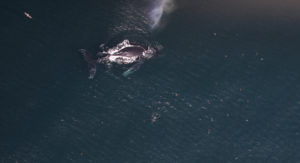They can plunge to depths of more than a mile and stay submerged for 90 minutes without coming up for air. They can swim up to 14,000 miles a year. The males can weigh over two and a half tons.
You could say elephant seals are “Extreme Mammals,” record-holders in several categories, including deepest divers. Yet I couldn’t help thinking, as I watched them lolling about Drake’s Beach one sunny February afternoon, these animals hardly looked capable of moving, much less performing the prodigious feats I’d read about.
I had the good fortune to observe the Point Reyes elephant seal colony at close range last month, while Dr. Sarah Allen led a small team of research assistants onto the beach to tag and count weaned pups, or “weaners.” We stood on a bluff while Dr. Allen gave me an overview, and thanks to her interpretations, what at first looked like randomly scattered blubber started to make sense.
A few hundred of the pinnipeds sprawled down the length of the beach. The weaners lay towards the back, roasting in the sun like fat, sandy sausages. They were enormous, and in fact Allen said they were some of the biggest she’s ever seen. Females and their nursing pups made up the bulk of the colony. Trying to avoid overheating on an unusually warm day, they congregated close to the water, flipping moist, cool sand onto their backs with their front flippers.
The massive bulk, large proboscis, and garish pink chest shields of the adult males made them easy to pick out. The dominant males, or “alphas,” stationed themselves at regular intervals throughout the colony, often right at the edge of the water. The “beta” males kept their distance, either at the edge of a harem or loitering in the water just beyond. Some of the females had already come into estrus, and the betas were biding their time, waiting to sneak past the alphas and make their move. Though the scene was for the most part peaceful, if noisy, Allen assured me conflicts could erupt at any moment.
- A mix of females, nursing young, and trumpeting male. Males and females come together to breed, but head to different parts of the Pacific for the rest of the year. Photo by Juliet Grable, taken with permission under NMFS permit #373 1868-00, issued to PRBO Conservation Science.
She had to speak loudly to make herself heard over the din of the colony and the constant pounding of the surf. Soon I could pick out individual calls from the cacophonous soundtrack. The urgent, insistent squeals of the pups and weaners reminded me of the cries of an agitated chimp. The females showed more range. They bellowed at each other and at amorous males, a noise that sounded like a drawn-out belch; other times they warbled to their pups, a higher-pitched chortle that was decidedly more lady-like. The trumpeting of the males, while more sporadic, was unmistakable: a hollow percussive beat that reverberated down the beach, sometimes staccato, sometimes drawn-out, always impressive.
I sat on a clump of vegetation at the back of the beach, watching Allen’s research assistant sneak up on the nearest weaner so she could tag him. Working quickly, she affixed a small pink coded tag to the seal’s hind flipper, which will hopefully last the animal’s lifetime. Allen’s team tags several hundred weaners each season. Among other things, the tags are helping researchers understand movement between colonies.
What the little pink tag won’t reveal is where the seal goes and what it’s doing when it’s not on land. Elephant seals spend 85 to 90 percent of their lives in the open ocean. Even though they are among the most-studied mammals in the world, much of that research has occurred on or near the beaches where the seals come to breed and molt. Until relatively recently, the pelagic part of their lives was a mystery.
Once researchers started attaching time-depth recorders to seals and beaming data back to the lab via satellite, everything changed. Satellite tags flung open a window into the elephant seals’ lives at sea, says Dr. Daniel Costa, a marine biologist who has been researching elephant seals and other marine mammals for more than 30 years.
Before satellite telemetry, researchers had to fly around in a plane or motor around in a ship in areas where they thought they might find the seals. Now, Costa says, “we let the animals show us where they are and where they are going.”
Costa participates in an effort called TOPP, short for Tagging of Pacific Predators. Begun in 2000 as part of the Census of Marine Life, TOPP is an ambitious, collaborative program designed to gather data about the movements and habitats of top predators inhabiting the Pacific Ocean. To date, TOPP researchers have tagged 22 species and over 2,000 individuals. The elephant seal has been one of TOPP’s stars.
By the late 1990s researchers had gained insight into the elephant seal’s astounding diving behavior. Not only do they routinely dive to 600 meters (the depth record previously held by Weddell seals), but they occasionally dive three times as deep: up to 1,800 meters, over a mile. What’s more, after staying underwater for half an hour or longer, the seals surface for just a few minutes before diving again. They can continue this pattern for months. Elephant seals accomplish this incredible feat through metabolic manipulation, slowing their hearts during dives–sometimes to a mere four ticks per minute–and diverting blood to important oxygen-dependent organs.
As they tagged and tracked more animals, researchers like Costa learned that males and females forage differently. After leaving the colony, females often head due west or northwest and feed in the water column on small to medium-sized prey like Pacific hake and squid. Males tend to head north/northwest, towards the Aleutian Islands. Once they reach the productive waters just off the continental shelf, they dive deep and spend most of their time near the bottom, most likely feeding on larger prey like sharks, rays, and rockfish. Males must eat three times as much as females to maintain their weight. After several months of serious bulking up, they swim all the way back to the colony to breed or molt.
It’s no wonder elephant seals spend so much time basking and dozing once they haul out on the beaches. By the time the females mate and wean their pups they’ve been fasting for over a month, all the while transferring energy directly to their pups, which can balloon from 60 to 300 pounds on nothing but mother’s milk. As Allen pointed out, some of the adult females at the Point Reyes colony were downright svelte; a few even looked like they had necks.
Ironically, the alpha males weren’t necessarily the largest. Some had arrived at the colony in December to stake out their territories, which meant they had been fasting for nearly three months and had lost a good amount of mass.
Allen pointed out a developing drama, an impertinent younger male making his move on a female. From 30 feet away, all the alpha had to do was lift his head and the young male immediately backed off. The alphas avoid direct contact–avoid moving, in fact. Allen explained the strategy: if raising the head doesn’t work, trumpet. If that doesn’t work, charge. When they have to, they can propel their bulk with alarming speed, or as Allen says, “faster than a biologist can run on sand.” Fighting is a last resort, and the duels typically don’t last long. The seals overheat easily and besides, they prefer to save their energy for mating.
That was last month; things are no doubt a lot quieter now. Most of the adults have probably left; the weaners will have the beach to themselves for a month or so. After teaching themselves how to swim and forage, they’ll strike out on their own, sticking closer to the coast at first, but eventually moving into the open ocean. According to Costa, the routes the pups establish have no correlation to their mothers’ routes. In other words, there is no “genetic blueprint” at work.
This is one of the conclusions researchers have drawn about the population, now that they have been collecting data for several years and have tagged over 300 animals. Another concerns the seals’ fidelity to migration routes. Costa claims once an individual seal establishes a route, it sticks to it. He cites a striking example: an individual he tagged and tracked in 1995, then again in 2006. When he laid the tracks from the two different years on top of each other, they were nearly identical.
This strategy works for a long-lived animal like the elephant seal. If, for instance, a female takes her customary route during an El Nino year, only to find a dearth of squid, she may not gain enough mass to carry a calf to term and nurse, in which case she simply won’t reproduce. That’s okay, because more than likely the next year she’ll do better. It’s a strategy of “betting on the average,” a strategy that could backfire if climate change leads to more permanent shifts in prey distribution or availability. He predicts that the younger animals whose routes haven’t fixed will adapt more readily than older animals, who are set in their ways.
Costa’s current research focuses on how elephant seals might react to potential climate change, and he’s using the seals to understand if those changes are already under way. In recent years tagged seals have become oceanographers. In addition to tracking an animal’s location and migration route, the tags can now collect information on temperature, depth, and salinity that would otherwise be costly, if not impossible, to obtain.
That new data reveals a lot about the nature of marine environment. Costa says having this information is akin to the animal showing us whether they’re in a grassland or a forest, and even where they are in that forest. For though the ocean may look homogenous from the surface, underneath it’s as variable as the terrestrial environment. Different layers of the ocean have characteristics that attract different species, just as some creatures live in the forest canopy and others live in the understory. Some areas are more productive than others. If and when changes occur, there will be winners and losers.
Costa has a hunch that elephant seals will weather climate change better than some species. The pinniped has proven to be the “poster child of conservation success,” recovering from an estimated low of fewer than a hundred individuals to over 100,000.
Just one more example of the elephant seal’s capacity for the extreme.
You can visit the seals yourself at Point Reyes or Ano Nuevo State Park.

.jpg)




